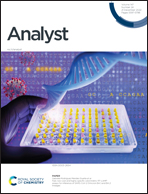Specific detection of fusion transcripts based on a duplex-specific nuclease and isothermal exponential amplification reaction†
Abstract
Fusion genes are mostly found in tumor tissues, but are in low expression levels in healthy tissues, making them good candidate biomarkers for tumor diagnosis and therapy. Here, we propose a duplex-specific nuclease-isothermal exponential amplification reaction (DSN-IEXPAR) method for the detection of fusion transcripts. A DNA probe is specifically designed for fusion transcript recognition and hybridization, and DSN cleavages the DNA probe in the DNA/RNA duplex. Through controlling the recognition and cleavage temperature, DSN can only cut the DNA probe fully matched with the target fusion transcript rather than other transcripts containing partial the same sequence, endowing the proposed method with high specificity to the fusion transcript in the presence of homologous sequences. The truncated DNA probe after cutting can subsequently trigger IEXPAR as a probe, so as low as 100 fM fusion transcript can be detected with the proposed DSN-IEXPAR. The evaluation of the analytical performance of DSN-IEXPAR demonstrates that it can provide an effective platform for fusion transcript detection in the ordinary laboratory and clinical diagnosis.

- This article is part of the themed collection: Analyst HOT Articles 2022


 Please wait while we load your content...
Please wait while we load your content...